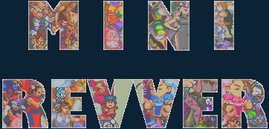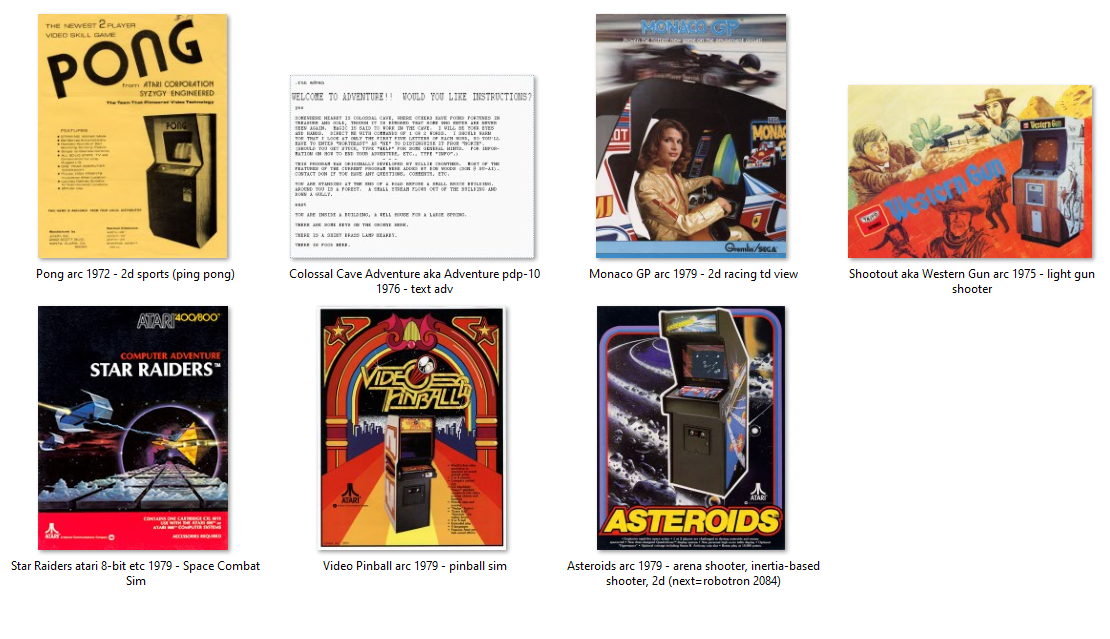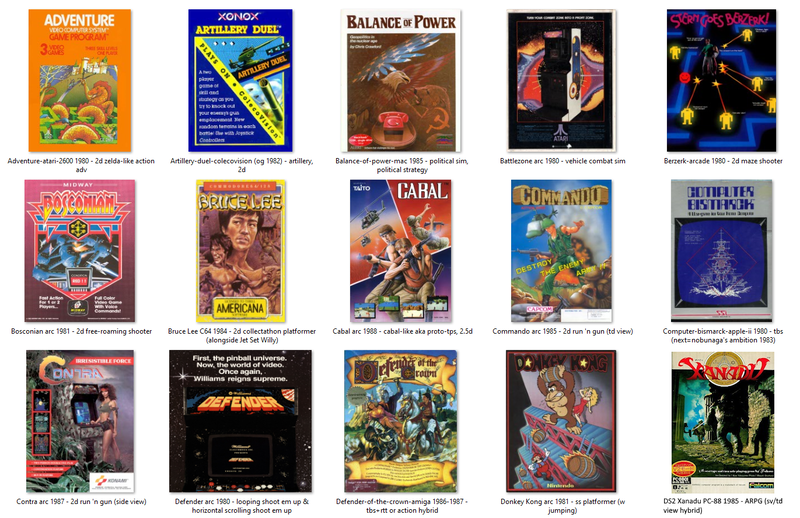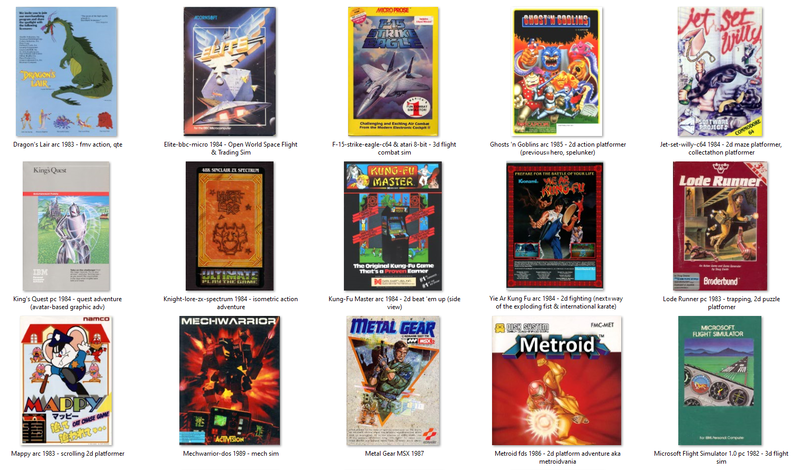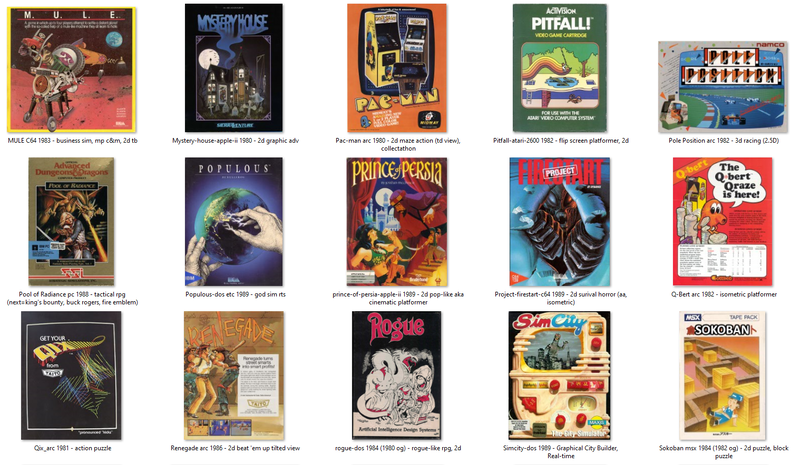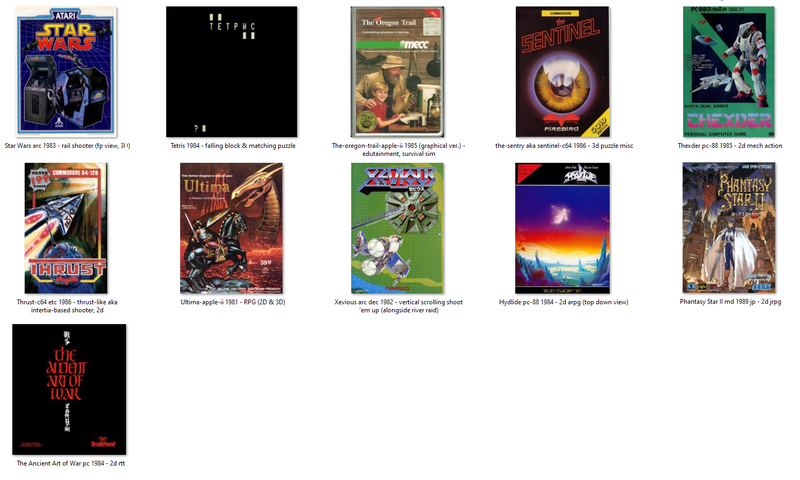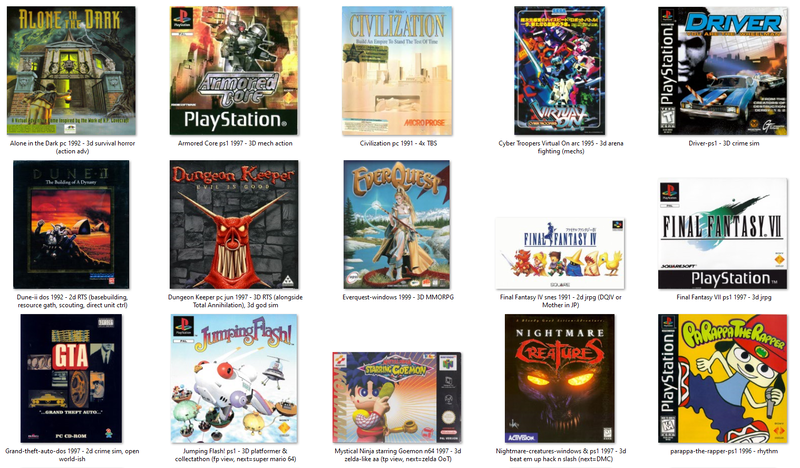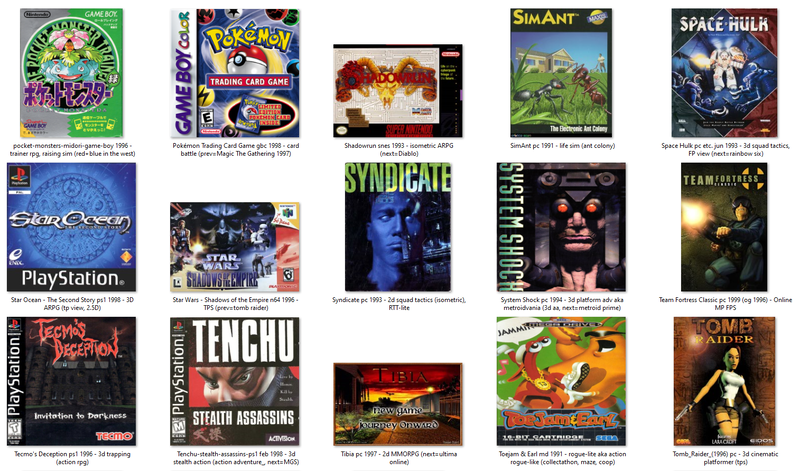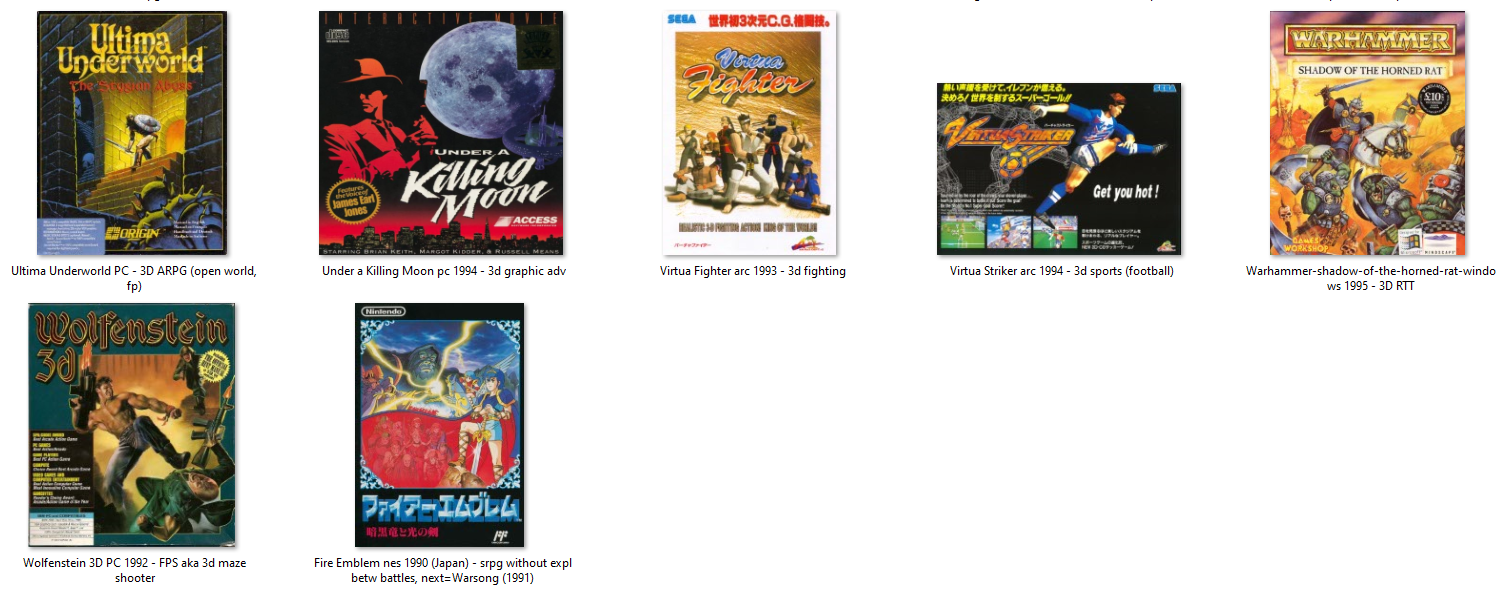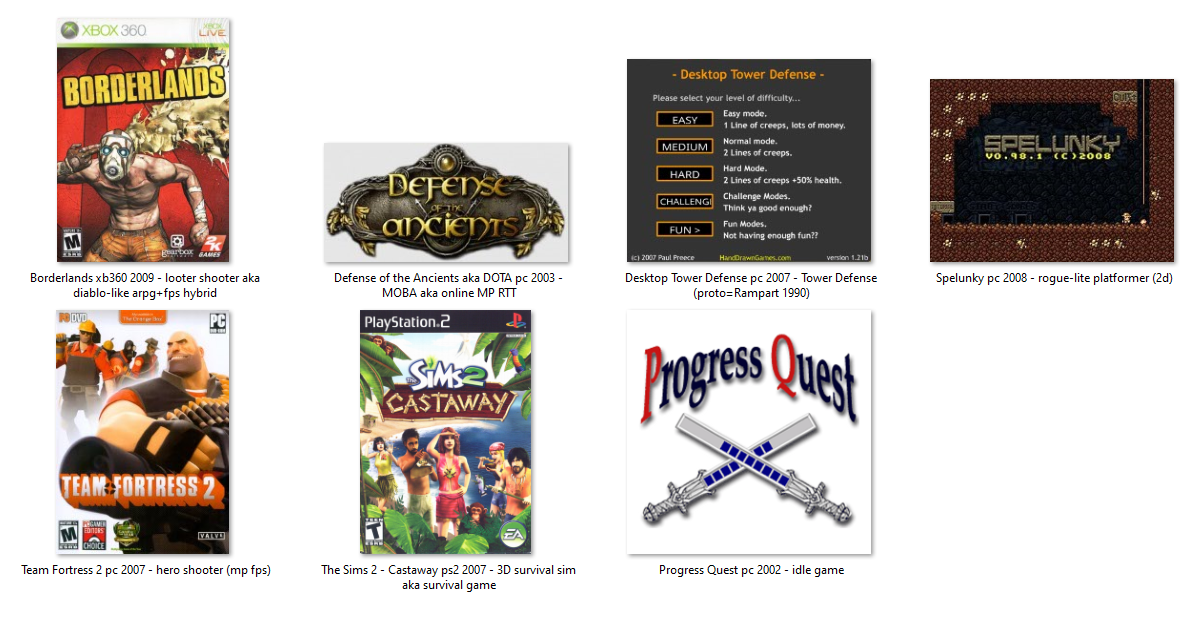The First Popular Game in Each Genre (1970s-1990s)
Sources: Wikipedia, Youtube, ChatGPT, Bing
1970s:
Racing (Top Down 2D): Monaco GP (1979) followed by Spy Hunter (1983) and Super Sprint (1986, single screen)
Light Gun Shooter: Shootout/Western Gun (1975) followed by Crossbow (1983)
Space Combat Sim (2.5D or 3D): Star Raiders (1979, sprite-based) followed by Elite (1984, open world, trading)
Sports (2D): Pong (1972, ping pong/tennis) followed by Atari Football (ARC, 1978)
Pinball or Pinball/Action hybrid: Video Pinball (1979/1981) followed by Pinball Construction Set (1982/1983), Revenge of the Gator (1989) and Pinball Quest (1989)
Text Adventure: Colossal Cave Adventure (1976) followed by Zork: The Great Underground Empire (1980)
Arena Shooter/Robotron-like (generally twin stick shooters, Top Down): Asteroids (1979, inertia-based arena shooter), followed by Robotron 2084 (1982) and Smash TV (1990, maze element)
1980s:
Open World Action Adventure (2D, Top Down/Tilted View): Adventure (1980)(also the first Zelda-like AA) followed by The Legend of Zelda (feb. 1986) and Metroid (aug. 1986, side view)
Artillery (2D, turn-based): Artillery Duel (1983) followed by Scorched Earth (1991)
Political Strategy/Sim: Balance of Power (1985) followed by Hidden Agenda (1988)
Vehicle Combat Sim (2.5D & 3D): Battlezone (1980, tank-based) followed by MechWarrior (1989, mech sim) and Twisted Metal (1995, car combat)
2D Maze Shooter (Top Down): Berzerk (1980) followed by Paradroid (1985, action puzzle hybrid) and Alien Syndrome (1986)
Free-Roaming Shooter (Vehicle-based, Top Down): Bosconian (1981)(autoscrolling) followed by Time Pilot (1982), Sinistar (1983), Rambo: First Blood Part II (1985, Spectrum ver.), Thunder Force II (1988, part horizontal shoot 'em up), Desert Strike (1992, isometric) and Cannon Fodder (1993, squad tactics)
Collectathon Platformer (2D): Bruce Lee (april, 1984), Jet Set Willy (1984) and Impossible Mission (1984) followed by Monty on the Run (1985), Dizzy: The Ultimate Cartoon Adventure (1986), Wizards & Warriors (1987) and Rainbow Islands (1987, vertical platformer)
Run 'n Gun (Top Down view): Commando (1985) followed by Ikari Warriors (1986) and Mercs (1990)
Cabal-like/Proto-TPS or "Gallery Shooter" (limited movement, 2.5D): Cabal (1988) followed by Blood Bros. (1990)
TBS (Turn-Based Strategy): Computer Bismarck (1980) followed by Nobunaga no Yabou/Nobunaga's Ambition (1983) and Romance of the Three Kingdoms (1985, Government Sim/TBS)
Run 'n Gun (Platformer/SEU hybrid, Side View): Contra (1987/1988, 2-player coop) followed by Sunset Riders (1991)
Defender-like/Looping Shooter (side view/horizontal scrolling): Defender (1980) (also an auto-scrolling horizontal Shoot 'em up) followed by Fantasy Zone (1986)
TBS/Action Hybrid: Archon (1983, chess variant+1 vs 1 arena combat) followed by Defender of the Crown (1986, 1987 ST ver. had tactical battles) and by North & South (1989)
Single Screen Platformer: Donkey Kong (jul 1981, temporary weapon power up) followed by Mario Bros. (jul 1983)
ARPG/Action RPG (2D Side View, non-Open World): Dragon Slayer II: Xanadu (1985, separate td view combat, ARPG)(in Japan), Zelda II (jan 1987), Faxanadu (nov 1987) followed by Cadash (1989 or 1990)
FMV Action: Dragon's Lair (1983, FMV/QTE action)
Open World Space Flight/Trading Sim (AA, 3D): Elite (1984) followed by Frontier: Elite II (1993)
Flight Combat Sim (3D): F-15 Strike Eagle (1984) followed by F-19 Stealth Fighter (1988)
Action Platformer (Combat-focused Platformer): Spelunker (PCs, 1983/ARC, 1985, maze platformer), Ghosts 'n Goblins (jul 1985), Castlevania (1986), Wonder Boy (1986), Alex Kidd in Miracle World (1986, some maze levels)
Maze Platformer: Jet Set Willy (1984) followed by Monty on the Run (1985), Dizzy: The Ultimate Cartoon Adventure (1986), Wizards & Warriors (1987) and New Zealand Story (1988, some maze levels, shooter)
Quest Adventure/Point & Click Adventure (avatar-based): King's Quest (1984/1989/1990) followed by King's Quest II (may 1985), Maniac Mansion (oct 1987) and Space Quest IV (1991)
Isometric Action Adventure/Platform Adventure: Knight Lore (1984, no ability gating) followed by Batman (1986, some ability gating)
Beat 'em up/Hack 'n Slash (Side View, 2D): Kung Fu/Kung-Fu Master (1984) followed by Altered Beast (1988) and Bad Dudes (1989)
Fighting (2D): Yie Ar Kung-Fu (ARC, oct 1984), Kung-Fu: The Way of the Exploding Fist (may 1985), followed by International Karate (nov 1985), Street Fighter (aug 1987) & IK+ (oct 1987)
Trapping/Trap 'em up (Puzzle/Tactics offshoot, Side View): Lode Runner (1983)(also the first popular Puzzle Platformer) followed by Spy vs Spy (1984) and Ghostbusters (1984, Spectrum ver., Misc. Action hybrid), Boulder Dash (march 1984) and Solomon's Key (1986)
Platformer/Hop 'n Bop Platformer (2D): Pitfall! (1982, flip screen), Mappy (1983, scrolling), Bubble Bobble (1986, single screen) - 2-player coop
Mech Sim (3D): MechWarrior (PC, 1989) followed by MechWarrior 2: 31st Century Combat (PC, 1995)
Stealth Action (2D): Metal Gear (1987, AA) followed by Metal Gear: Ghost Babel (2000)(Bonanza Bros (1990) was also moderately popular)
Platform Adventure/Metroidvania (2D, side view): Dragon Slayer II: Xanadu (1985, separate td view combat, ARPG)(in Japan), Metroid (1986) followed by Zelda II (jan 1987), Faxanadu (nov 1987) and Blaster Master (1988)
Flight Sim (3D): Microsoft Flight Simulator (1982) followed by F-19 Stealth Fighter (1988)
Business Sim (Construction & Management): M.U.L.E. (1983, MP, trading) followed by Railroad Tycoon (1990)
Graphic Adventure/Visual Novel (2D, generally FP view): Mystery House (may 1980) followed by The Wizard and the Princess (aug 1980), Portopia Renzoku Satsujin Jiken (1983)(in Japan) and King's Quest (1984)
Maze Action (2D): Pac-Man (jul 1980, maze/collectathon, TD view) followed by Lady Bug (1981) and Pengo (1982)
Racing (2.5D or 3D): Pole Position (1982) followed by Out Run (1986), Super Monaco GP (1989) and Stunts/4D Sports Driving (1990)
SRPG/TRPG (w/ exploration between battles): Pool of Radiance (1988, FP exploration, perma-death), Buck Rogers: Countdown to Doomsday (1990, partial FP exploration on PCs), King's Bounty (1990/MD, 1991, real-time enemy enc during expl on MD), followed by X-COM: UFO Defense (1994) and Heroes of Might and Magic II (1996)
God Sim/God Game: Populous (1989, 2D) followed by Populous II: Trials of the Olympian Gods (1991), Dungeon Keeper (jun 1997, C&M/RTS hybrid w/ FPS & RPG elements, 2D units) and Black & White (2000, fully 3D)
Prince of Persia-style Puzzle Platformer/Cinematic Platformer (2D): Prince of Persia (1989) followed by Another World/Out of This World (1991)
Survival Horror (AA or ARPG, 2D): Project Firestart (1989) & Sweet Home (1989, party-based JRPG w/ SH elements)(in Japan); Friday the 13th (NES, 1989) - more well known but had a mixed reception
Isometric Platformer: Q*Bert (1982) followed by Knight Lore (1984, AA/puzzle)
Action Puzzle (real-time w/ a timing element): Qix (1981, trapping element) followed by Tetris (1984, falling block/matching)
Beat 'em up/Hack 'n Slash (Tilted view, 2D): Renegade (1986) followed by Double Dragon (1987) and Golden Axe (jun 1989)
Rogue-like/Roguelike (Dungeon Crawler RPG variant, semi-TB): Rogue (1980) followed by NetHack (1987)
City Builder/Construction & Management: SimCity (1989/SNES, 1991, city builder) followed by SimCity 2000 (PC, 1993)
Misc. Puzzle (2D): Sokoban aka Boxyboy/Shove It! (1982) followed by The Adventures of Lolo (1989)
Rail Shooter (2.5D & 3D): Star Wars (1983, FP view, 3D) followed by Space Harrier (1985) and After Burner (1987)
Falling Block (Stacking) & Matching Puzzle: Tetris (1984/1989/1994) followed by Columns (1990) and Dr. Mario (1990)
Edutainment: The Oregon Trail (1985/1993 (graphical version), survival/travel, edutainment)(also the first popular survival game/survival sim), Where in the World Is Carmen Sandiego? (april 1985)
Misc. Puzzle (3D): The Sentry/The Sentinel (1986) followed by Myst (1993, graphic adventure)
Mech Action (2D): Thexder (april 1985)(also one of the first popular scrolling platformers) followed by Cybernator/Assault Suits Valken (1992) and Metal Warriors (1995)
Thrust-like/Gravity-based Shooter (2D): Thrust (1986) followed by Solar Jetman: Hunt for the Golden Warpship (1990)
RPG (2D, generally TD view besides combat): Ultima I: The First Age of Darkness (1981, FP view hybrid so 2D & 3D) followed by Wizardry: Proving Grounds of the Mad Overlord (1981)
Auto-scrolling Shoot 'em up (Vertical Scrolling, Top Down View): River Raid (dec 1982) & Xevious (dec 1982) followed by 1943: The Battle of Midway (1987)(1942 (1984) and Twin Cobra (1987) were also fairly popular)
ARPG (2D Top Down/Tilted View, non-Open World): Hydlide (1984)(in Japan), Ys: Vanished Omen (1987) followed by Final Fantasy Adventure/Seiken Densetsu: Final Fantasy Gaiden (1991) and Secret of Mana/Seiken Densetsu 2 (1993, party-based)
JRPG/Linear RPG (2D)(Character development/characterization, Linear or mostly linear progression, Predefined characters and story, Anime or manga aesthetics, Tactical if not TB combat): Phantasy Star II (march, 1989), Mother/Earthbound Beginnings (july 1989, mostly non-linear?, barebones characterization?)(in Japan), Dragon Quest IV (1990, chapter-based)(in Japan), Final Fantasy IV (1991)
RTT/Real-Time Tactics (2D): The Ancient Art of War (1984), followed by Herzog Zwei (1989, player avatar-based, proto-RTS/proto-MOBA) and General Chaos (1993)
1990s:
SRPG (w/o exploration between battles): Fire Emblem (1990, perma-death) followed by Langrisser/Warsong (1991) and Super Robot Taisen (Super Robot Wars)(GB, 1991), Fire Emblem: Mystery of the Emblem (1994)(in Japan) and Final Fantasy Tactics (1997)
God Sim/God Game (3D): Dungeon Keeper (jun 1997, C&M/RTS hybrid w/ FPS & RPG elements, 2D units) followed by Black & White (2000, fully 3D)
FPS/3D Maze Shooter: Wolfenstein 3D (1992) followed by Doom (1993), Heretic (1994), Star Wars: Dark Forces (1995) and Duke Nukem 3D (jan 1996)
MMORPG: Tibia (jan 1997, 2D) followed by Ultima Online (1997) and Everquest (1999, 3D)
4X TBS: Sid Meier's Civilization (1991) followed by Civilization II (1996) and Age of Wonders (1999)
Life Sim/Virtual Life: SimAnt (1991, ant colony) followed by Tamagotchi (GB, 1997, virtual pet) and The Sims (feb 2000)
3D ARPG (FP view): Ultima Underworld (1992, open world) followed by The Elder Scrolls: Arena (march 1994, FP view, open world) and King's Field (dec 1994, FP view)(in Japan); TP view: Star Ocean: The Second Story (1998, 2.5D)
Open World AA/ARPG (3D): Ultima Underworld: The Stygian Abyss (1992, FP view ARPG, Immersive Sim?) & The Elder Scrolls: Arena (march 1994, FP view)
Mech Action (3D): Armored Core (1997, mech sim-lite) followed by Zone of the Enders (2001)
Squad Tactics (real-time, 2D): Syndicate (1993, TBS elements) followed by Commandos: Behind Enemy Lines (1998, stealth hybrid)
Squad Tactics (real-time, 3D): Space Hulk (jun 1993, 2.5D, FP RTT/squad combat, horror) followed by Tom Clancy's Rainbow Six (1998, FPS)
RTT (3D): Warhammer: Shadow of the Horned Rat (1995) followed by Myth: The Fallen Lords (1997), Myth II: Soulblighter (1998), Warhammer: Dark Omen (1998) and Ground Control (2000)
Rhythm/Music: Parappa the Rapper (1996) followed by Dance Dance Revolution (1998)
RTS/Real-Time Strategy (2D)(Base-building, Resource Gathering, Unit training, Scouting, Direct unit control): Dune II (1992/1993) followed by Command & Conquer (1995) and Warcraft II: Tides of Darkness (1995)
RTS (3D): Dungeon Keeper (jun 1997, C&M hybrid w/ FPS & RPG elements, 2D units) and Total Annihilation (sept 1997, 2.5D-ish) followed by Populous: The Beginning aka Populous 3 (1998, 2D units) and Homeworld (1999, continuous army)
3D Zelda-like Action Adventure: System Shock (1994, FP view, survival horror/MV-ish, some platforming) and Mystical Ninja starring Goemon (N64, 1997, platforming) followed by The Legend of Zelda: Ocarina of Time (1998) and Legacy of Kain: Soul Reaver (1999)
Platform Adventure/Metroidvania (3D): System Shock (1994, FP view, minor ability gating and not that much platforming) or Mystical Ninja starring Goemon (1997, zelda-like w/ platforming), Legacy of Kain: Soul Reaver (1999, zelda-like w/ platforming), Metroid Prime (2002)
Sports (3D): Virtua Striker (1994, football/soccer) followed by FIFA Soccer '96 (PS1, 1995), NFL Blitz (1997) and International Superstar Soccer Pro Evolution (1997)
Multiplayer FPS/MP FPS (Online MP): Team Fortress (1996, mod for Quake - standalone release in 1999) followed by Unreal Tournament (nov 1999), Quake III Arena (dec 1999) and Counter-Strike (nov 2000, HL1 mod)
Card Battle (TB): Magic: The Gathering (1997), Pokemon Trading Card Game (1998) followed by Yu-Gi-Oh! Trading Card Game (1999), Magic: The Gathering Online (2002) and Duel Masters Trading Card Game (2002)
Arena Fighting: Outfoxies (1995, 2D side view), Virtual On/Virtual-On (jan 1996, 3D TP view, mechs) followed by Power Stone (1999) and Super Smash Bros. (1999, 2.5D)
3D JRPG - Final Fantasy VII (1997)
Crime Sim (2D): Grand Theft Auto/GTA (1997, semi-OW) followed by Grand Theft Auto 2 (1999, semi-OW)
Crime Sim (3D): Driver (1999, car-based) followed by Grand Theft Auto III (2001)
Stealth Action (2.5D or 3D): Tenchu: Stealth Assassins (feb 1998, TP view) followed by Metal Gear Solid (sept 1998, TP/TD/FP view) and Thief (dec 1998, FP view)
Isometric ARPG/Diablo-like ARPG (KB & Mouse controls): Shadowrun (1993, real-time w/ pause combat, P&C combat and world interaction), Diablo (1996) followed by Nox (feb 2000) and Diablo II (jun 2000)
Fighting (3D): Virtua Fighter (1993) followed by Virtua Fighter 2 (1994) and Tekken (1994)
Trapping (3D): Tecmo's Deception: Invitation to Darkness (1996, FP ARPG) followed by Kagero: Deception II (1998)
Graphic Adventure (2.5D or 3D): Under a killing Moon (1994, real-time 3D/FMV hybrid) followed by followed by Clock Tower (1996 ver., Survival Horror), Grim Fandango (1998, pre-rendered backgrounds), The Longest Journey (1999, pre-rendered backgrounds) and Gabriel Knight 3: Blood of the Sacred, Blood of the Damned (1999)
Survival Horror (AA or ARPG, 2.5D & 3D): Alone in the Dark (1992), System Shock (1994, FP view) followed by Resident Evil (1996) and Clock Tower (1996 ver., P&C Adventure hybrid)
Beat 'em up/Hack 'n Slash (3D): Die Hard Arcade/Dynamite Deka (1996, 2.5D), Nightmare Creatures (1997, hack 'n slash, horror), Devil May Cry (2001, AA elements)
TPS/Third-Person Shooter (3D): Tomb Raider (oct 1996, maze/puzzle platformer aka cinematic platformer) and Star Wars: Shadows of the Empire (dec 1996, vehicle segments) followed by Syphon Filter (1999) and Max Payne (2001)
Cinematic Platformer (3D): Tomb Raider (1996, TPS hybrid) followed by Tomb Raider II (1997), Tomb Raider III: Adventures of Lara Croft (1998), Ico (2001) and Tomb Raider: Legend (2006)
3D Platformer: Jumping Flash! (1995, FP view) - 3D collectathon platformer as well, Super Mario 64 (jun 1996), Crash Bandicoot (sept 1996, on rails) & Tomb Raider (oct 1996, maze/puzzle platformer/TPS)
Rogue-lite/Action Rogue-like (2D): Toejam & Earl (1991, TD maze action/collectathon) followed by Spelunky (2008, side view platformer)
Trainer RPG/Raising Sim RPG: Pokemon Blue/Red/Green (1996) followed by Monster Rancher (1997), Medabots (1997)(in Japan), Dragon Warrior Monsters (1998)(in Japan) and Digimon World (1999)
Systemic Game/Immersive Sim (player avatar-based, consistent and interacting systems, multiple solutions to problems that aren't necessarily intended by devs, little handholding, generally AA/ARPG): Ultima Underworld: The Stygian Abyss (1992, 3D, FP view WRPG/ARPG, Open World) followed by System Shock (1994, MV/SH), System Shock 2 (1999, ARPG/SH/MV-lite) and Deus Ex (2000, ARPG, Stealth)
2000s WIP:
Multiplayer Online Battle Arena/MOBA (Online RTT): Defense of the Ancients/DotA (2003, custom map for Warcraft III) followed by League of Legends (2009)
Tower Defense (RTS/RTT): Warcraft III (Element TD and Gem Tower Defense custom maps from 2006) & Desktop Tower Defense (2007) followed by Plants vs. Zombies (2009) and Kingdom Rush (2011)
Rogue-lite/Action Rogue-like Platformer (2D): Spelunky (2008) followed by Rogue Legacy (2013, ARPG)
3D Survival Sim/Survival Game: The Sims 2: Castaway (2007, 3D, life sim) followed by Minecraft (2011) and Don't Starve (2013, rogue-lite)
Hero Shooter (MP FPS w/ unique characters instead of classes or generic models): Team Fortress 2 (2007) followed by Battleborn (may 3rd 2016) and Overwatch (may 24th 2016)
Looter Shooter aka Diablo-like ARPG/FPS Hybrid: Borderlands (2009) followed by Warframe (2013) and Destiny (2014)
Incremental Game/Idle Game: Progress Quest (2002, RPG) followed by Cookie Clicker (2013) and Candy Box! (2013)
1970s:
Racing (Top Down 2D): Monaco GP (1979) followed by Spy Hunter (1983) and Super Sprint (1986, single screen)
Light Gun Shooter: Shootout/Western Gun (1975) followed by Crossbow (1983)
Space Combat Sim (2.5D or 3D): Star Raiders (1979, sprite-based) followed by Elite (1984, open world, trading)
Sports (2D): Pong (1972, ping pong/tennis) followed by Atari Football (ARC, 1978)
Pinball or Pinball/Action hybrid: Video Pinball (1979/1981) followed by Pinball Construction Set (1982/1983), Revenge of the Gator (1989) and Pinball Quest (1989)
Text Adventure: Colossal Cave Adventure (1976) followed by Zork: The Great Underground Empire (1980)
Arena Shooter/Robotron-like (generally twin stick shooters, Top Down): Asteroids (1979, inertia-based arena shooter), followed by Robotron 2084 (1982) and Smash TV (1990, maze element)
1980s:
Open World Action Adventure (2D, Top Down/Tilted View): Adventure (1980)(also the first Zelda-like AA) followed by The Legend of Zelda (feb. 1986) and Metroid (aug. 1986, side view)
Artillery (2D, turn-based): Artillery Duel (1983) followed by Scorched Earth (1991)
Political Strategy/Sim: Balance of Power (1985) followed by Hidden Agenda (1988)
Vehicle Combat Sim (2.5D & 3D): Battlezone (1980, tank-based) followed by MechWarrior (1989, mech sim) and Twisted Metal (1995, car combat)
2D Maze Shooter (Top Down): Berzerk (1980) followed by Paradroid (1985, action puzzle hybrid) and Alien Syndrome (1986)
Free-Roaming Shooter (Vehicle-based, Top Down): Bosconian (1981)(autoscrolling) followed by Time Pilot (1982), Sinistar (1983), Rambo: First Blood Part II (1985, Spectrum ver.), Thunder Force II (1988, part horizontal shoot 'em up), Desert Strike (1992, isometric) and Cannon Fodder (1993, squad tactics)
Collectathon Platformer (2D): Bruce Lee (april, 1984), Jet Set Willy (1984) and Impossible Mission (1984) followed by Monty on the Run (1985), Dizzy: The Ultimate Cartoon Adventure (1986), Wizards & Warriors (1987) and Rainbow Islands (1987, vertical platformer)
Run 'n Gun (Top Down view): Commando (1985) followed by Ikari Warriors (1986) and Mercs (1990)
Cabal-like/Proto-TPS or "Gallery Shooter" (limited movement, 2.5D): Cabal (1988) followed by Blood Bros. (1990)
TBS (Turn-Based Strategy): Computer Bismarck (1980) followed by Nobunaga no Yabou/Nobunaga's Ambition (1983) and Romance of the Three Kingdoms (1985, Government Sim/TBS)
Run 'n Gun (Platformer/SEU hybrid, Side View): Contra (1987/1988, 2-player coop) followed by Sunset Riders (1991)
Defender-like/Looping Shooter (side view/horizontal scrolling): Defender (1980) (also an auto-scrolling horizontal Shoot 'em up) followed by Fantasy Zone (1986)
TBS/Action Hybrid: Archon (1983, chess variant+1 vs 1 arena combat) followed by Defender of the Crown (1986, 1987 ST ver. had tactical battles) and by North & South (1989)
Single Screen Platformer: Donkey Kong (jul 1981, temporary weapon power up) followed by Mario Bros. (jul 1983)
ARPG/Action RPG (2D Side View, non-Open World): Dragon Slayer II: Xanadu (1985, separate td view combat, ARPG)(in Japan), Zelda II (jan 1987), Faxanadu (nov 1987) followed by Cadash (1989 or 1990)
FMV Action: Dragon's Lair (1983, FMV/QTE action)
Open World Space Flight/Trading Sim (AA, 3D): Elite (1984) followed by Frontier: Elite II (1993)
Flight Combat Sim (3D): F-15 Strike Eagle (1984) followed by F-19 Stealth Fighter (1988)
Action Platformer (Combat-focused Platformer): Spelunker (PCs, 1983/ARC, 1985, maze platformer), Ghosts 'n Goblins (jul 1985), Castlevania (1986), Wonder Boy (1986), Alex Kidd in Miracle World (1986, some maze levels)
Maze Platformer: Jet Set Willy (1984) followed by Monty on the Run (1985), Dizzy: The Ultimate Cartoon Adventure (1986), Wizards & Warriors (1987) and New Zealand Story (1988, some maze levels, shooter)
Quest Adventure/Point & Click Adventure (avatar-based): King's Quest (1984/1989/1990) followed by King's Quest II (may 1985), Maniac Mansion (oct 1987) and Space Quest IV (1991)
Isometric Action Adventure/Platform Adventure: Knight Lore (1984, no ability gating) followed by Batman (1986, some ability gating)
Beat 'em up/Hack 'n Slash (Side View, 2D): Kung Fu/Kung-Fu Master (1984) followed by Altered Beast (1988) and Bad Dudes (1989)
Fighting (2D): Yie Ar Kung-Fu (ARC, oct 1984), Kung-Fu: The Way of the Exploding Fist (may 1985), followed by International Karate (nov 1985), Street Fighter (aug 1987) & IK+ (oct 1987)
Trapping/Trap 'em up (Puzzle/Tactics offshoot, Side View): Lode Runner (1983)(also the first popular Puzzle Platformer) followed by Spy vs Spy (1984) and Ghostbusters (1984, Spectrum ver., Misc. Action hybrid), Boulder Dash (march 1984) and Solomon's Key (1986)
Platformer/Hop 'n Bop Platformer (2D): Pitfall! (1982, flip screen), Mappy (1983, scrolling), Bubble Bobble (1986, single screen) - 2-player coop
Mech Sim (3D): MechWarrior (PC, 1989) followed by MechWarrior 2: 31st Century Combat (PC, 1995)
Stealth Action (2D): Metal Gear (1987, AA) followed by Metal Gear: Ghost Babel (2000)(Bonanza Bros (1990) was also moderately popular)
Platform Adventure/Metroidvania (2D, side view): Dragon Slayer II: Xanadu (1985, separate td view combat, ARPG)(in Japan), Metroid (1986) followed by Zelda II (jan 1987), Faxanadu (nov 1987) and Blaster Master (1988)
Flight Sim (3D): Microsoft Flight Simulator (1982) followed by F-19 Stealth Fighter (1988)
Business Sim (Construction & Management): M.U.L.E. (1983, MP, trading) followed by Railroad Tycoon (1990)
Graphic Adventure/Visual Novel (2D, generally FP view): Mystery House (may 1980) followed by The Wizard and the Princess (aug 1980), Portopia Renzoku Satsujin Jiken (1983)(in Japan) and King's Quest (1984)
Maze Action (2D): Pac-Man (jul 1980, maze/collectathon, TD view) followed by Lady Bug (1981) and Pengo (1982)
Racing (2.5D or 3D): Pole Position (1982) followed by Out Run (1986), Super Monaco GP (1989) and Stunts/4D Sports Driving (1990)
SRPG/TRPG (w/ exploration between battles): Pool of Radiance (1988, FP exploration, perma-death), Buck Rogers: Countdown to Doomsday (1990, partial FP exploration on PCs), King's Bounty (1990/MD, 1991, real-time enemy enc during expl on MD), followed by X-COM: UFO Defense (1994) and Heroes of Might and Magic II (1996)
God Sim/God Game: Populous (1989, 2D) followed by Populous II: Trials of the Olympian Gods (1991), Dungeon Keeper (jun 1997, C&M/RTS hybrid w/ FPS & RPG elements, 2D units) and Black & White (2000, fully 3D)
Prince of Persia-style Puzzle Platformer/Cinematic Platformer (2D): Prince of Persia (1989) followed by Another World/Out of This World (1991)
Survival Horror (AA or ARPG, 2D): Project Firestart (1989) & Sweet Home (1989, party-based JRPG w/ SH elements)(in Japan); Friday the 13th (NES, 1989) - more well known but had a mixed reception
Isometric Platformer: Q*Bert (1982) followed by Knight Lore (1984, AA/puzzle)
Action Puzzle (real-time w/ a timing element): Qix (1981, trapping element) followed by Tetris (1984, falling block/matching)
Beat 'em up/Hack 'n Slash (Tilted view, 2D): Renegade (1986) followed by Double Dragon (1987) and Golden Axe (jun 1989)
Rogue-like/Roguelike (Dungeon Crawler RPG variant, semi-TB): Rogue (1980) followed by NetHack (1987)
City Builder/Construction & Management: SimCity (1989/SNES, 1991, city builder) followed by SimCity 2000 (PC, 1993)
Misc. Puzzle (2D): Sokoban aka Boxyboy/Shove It! (1982) followed by The Adventures of Lolo (1989)
Rail Shooter (2.5D & 3D): Star Wars (1983, FP view, 3D) followed by Space Harrier (1985) and After Burner (1987)
Falling Block (Stacking) & Matching Puzzle: Tetris (1984/1989/1994) followed by Columns (1990) and Dr. Mario (1990)
Edutainment: The Oregon Trail (1985/1993 (graphical version), survival/travel, edutainment)(also the first popular survival game/survival sim), Where in the World Is Carmen Sandiego? (april 1985)
Misc. Puzzle (3D): The Sentry/The Sentinel (1986) followed by Myst (1993, graphic adventure)
Mech Action (2D): Thexder (april 1985)(also one of the first popular scrolling platformers) followed by Cybernator/Assault Suits Valken (1992) and Metal Warriors (1995)
Thrust-like/Gravity-based Shooter (2D): Thrust (1986) followed by Solar Jetman: Hunt for the Golden Warpship (1990)
RPG (2D, generally TD view besides combat): Ultima I: The First Age of Darkness (1981, FP view hybrid so 2D & 3D) followed by Wizardry: Proving Grounds of the Mad Overlord (1981)
Auto-scrolling Shoot 'em up (Vertical Scrolling, Top Down View): River Raid (dec 1982) & Xevious (dec 1982) followed by 1943: The Battle of Midway (1987)(1942 (1984) and Twin Cobra (1987) were also fairly popular)
ARPG (2D Top Down/Tilted View, non-Open World): Hydlide (1984)(in Japan), Ys: Vanished Omen (1987) followed by Final Fantasy Adventure/Seiken Densetsu: Final Fantasy Gaiden (1991) and Secret of Mana/Seiken Densetsu 2 (1993, party-based)
JRPG/Linear RPG (2D)(Character development/characterization, Linear or mostly linear progression, Predefined characters and story, Anime or manga aesthetics, Tactical if not TB combat): Phantasy Star II (march, 1989), Mother/Earthbound Beginnings (july 1989, mostly non-linear?, barebones characterization?)(in Japan), Dragon Quest IV (1990, chapter-based)(in Japan), Final Fantasy IV (1991)
RTT/Real-Time Tactics (2D): The Ancient Art of War (1984), followed by Herzog Zwei (1989, player avatar-based, proto-RTS/proto-MOBA) and General Chaos (1993)
1990s:
SRPG (w/o exploration between battles): Fire Emblem (1990, perma-death) followed by Langrisser/Warsong (1991) and Super Robot Taisen (Super Robot Wars)(GB, 1991), Fire Emblem: Mystery of the Emblem (1994)(in Japan) and Final Fantasy Tactics (1997)
God Sim/God Game (3D): Dungeon Keeper (jun 1997, C&M/RTS hybrid w/ FPS & RPG elements, 2D units) followed by Black & White (2000, fully 3D)
FPS/3D Maze Shooter: Wolfenstein 3D (1992) followed by Doom (1993), Heretic (1994), Star Wars: Dark Forces (1995) and Duke Nukem 3D (jan 1996)
MMORPG: Tibia (jan 1997, 2D) followed by Ultima Online (1997) and Everquest (1999, 3D)
4X TBS: Sid Meier's Civilization (1991) followed by Civilization II (1996) and Age of Wonders (1999)
Life Sim/Virtual Life: SimAnt (1991, ant colony) followed by Tamagotchi (GB, 1997, virtual pet) and The Sims (feb 2000)
3D ARPG (FP view): Ultima Underworld (1992, open world) followed by The Elder Scrolls: Arena (march 1994, FP view, open world) and King's Field (dec 1994, FP view)(in Japan); TP view: Star Ocean: The Second Story (1998, 2.5D)
Open World AA/ARPG (3D): Ultima Underworld: The Stygian Abyss (1992, FP view ARPG, Immersive Sim?) & The Elder Scrolls: Arena (march 1994, FP view)
Mech Action (3D): Armored Core (1997, mech sim-lite) followed by Zone of the Enders (2001)
Squad Tactics (real-time, 2D): Syndicate (1993, TBS elements) followed by Commandos: Behind Enemy Lines (1998, stealth hybrid)
Squad Tactics (real-time, 3D): Space Hulk (jun 1993, 2.5D, FP RTT/squad combat, horror) followed by Tom Clancy's Rainbow Six (1998, FPS)
RTT (3D): Warhammer: Shadow of the Horned Rat (1995) followed by Myth: The Fallen Lords (1997), Myth II: Soulblighter (1998), Warhammer: Dark Omen (1998) and Ground Control (2000)
Rhythm/Music: Parappa the Rapper (1996) followed by Dance Dance Revolution (1998)
RTS/Real-Time Strategy (2D)(Base-building, Resource Gathering, Unit training, Scouting, Direct unit control): Dune II (1992/1993) followed by Command & Conquer (1995) and Warcraft II: Tides of Darkness (1995)
RTS (3D): Dungeon Keeper (jun 1997, C&M hybrid w/ FPS & RPG elements, 2D units) and Total Annihilation (sept 1997, 2.5D-ish) followed by Populous: The Beginning aka Populous 3 (1998, 2D units) and Homeworld (1999, continuous army)
3D Zelda-like Action Adventure: System Shock (1994, FP view, survival horror/MV-ish, some platforming) and Mystical Ninja starring Goemon (N64, 1997, platforming) followed by The Legend of Zelda: Ocarina of Time (1998) and Legacy of Kain: Soul Reaver (1999)
Platform Adventure/Metroidvania (3D): System Shock (1994, FP view, minor ability gating and not that much platforming) or Mystical Ninja starring Goemon (1997, zelda-like w/ platforming), Legacy of Kain: Soul Reaver (1999, zelda-like w/ platforming), Metroid Prime (2002)
Sports (3D): Virtua Striker (1994, football/soccer) followed by FIFA Soccer '96 (PS1, 1995), NFL Blitz (1997) and International Superstar Soccer Pro Evolution (1997)
Multiplayer FPS/MP FPS (Online MP): Team Fortress (1996, mod for Quake - standalone release in 1999) followed by Unreal Tournament (nov 1999), Quake III Arena (dec 1999) and Counter-Strike (nov 2000, HL1 mod)
Card Battle (TB): Magic: The Gathering (1997), Pokemon Trading Card Game (1998) followed by Yu-Gi-Oh! Trading Card Game (1999), Magic: The Gathering Online (2002) and Duel Masters Trading Card Game (2002)
Arena Fighting: Outfoxies (1995, 2D side view), Virtual On/Virtual-On (jan 1996, 3D TP view, mechs) followed by Power Stone (1999) and Super Smash Bros. (1999, 2.5D)
3D JRPG - Final Fantasy VII (1997)
Crime Sim (2D): Grand Theft Auto/GTA (1997, semi-OW) followed by Grand Theft Auto 2 (1999, semi-OW)
Crime Sim (3D): Driver (1999, car-based) followed by Grand Theft Auto III (2001)
Stealth Action (2.5D or 3D): Tenchu: Stealth Assassins (feb 1998, TP view) followed by Metal Gear Solid (sept 1998, TP/TD/FP view) and Thief (dec 1998, FP view)
Isometric ARPG/Diablo-like ARPG (KB & Mouse controls): Shadowrun (1993, real-time w/ pause combat, P&C combat and world interaction), Diablo (1996) followed by Nox (feb 2000) and Diablo II (jun 2000)
Fighting (3D): Virtua Fighter (1993) followed by Virtua Fighter 2 (1994) and Tekken (1994)
Trapping (3D): Tecmo's Deception: Invitation to Darkness (1996, FP ARPG) followed by Kagero: Deception II (1998)
Graphic Adventure (2.5D or 3D): Under a killing Moon (1994, real-time 3D/FMV hybrid) followed by followed by Clock Tower (1996 ver., Survival Horror), Grim Fandango (1998, pre-rendered backgrounds), The Longest Journey (1999, pre-rendered backgrounds) and Gabriel Knight 3: Blood of the Sacred, Blood of the Damned (1999)
Survival Horror (AA or ARPG, 2.5D & 3D): Alone in the Dark (1992), System Shock (1994, FP view) followed by Resident Evil (1996) and Clock Tower (1996 ver., P&C Adventure hybrid)
Beat 'em up/Hack 'n Slash (3D): Die Hard Arcade/Dynamite Deka (1996, 2.5D), Nightmare Creatures (1997, hack 'n slash, horror), Devil May Cry (2001, AA elements)
TPS/Third-Person Shooter (3D): Tomb Raider (oct 1996, maze/puzzle platformer aka cinematic platformer) and Star Wars: Shadows of the Empire (dec 1996, vehicle segments) followed by Syphon Filter (1999) and Max Payne (2001)
Cinematic Platformer (3D): Tomb Raider (1996, TPS hybrid) followed by Tomb Raider II (1997), Tomb Raider III: Adventures of Lara Croft (1998), Ico (2001) and Tomb Raider: Legend (2006)
3D Platformer: Jumping Flash! (1995, FP view) - 3D collectathon platformer as well, Super Mario 64 (jun 1996), Crash Bandicoot (sept 1996, on rails) & Tomb Raider (oct 1996, maze/puzzle platformer/TPS)
Rogue-lite/Action Rogue-like (2D): Toejam & Earl (1991, TD maze action/collectathon) followed by Spelunky (2008, side view platformer)
Trainer RPG/Raising Sim RPG: Pokemon Blue/Red/Green (1996) followed by Monster Rancher (1997), Medabots (1997)(in Japan), Dragon Warrior Monsters (1998)(in Japan) and Digimon World (1999)
Systemic Game/Immersive Sim (player avatar-based, consistent and interacting systems, multiple solutions to problems that aren't necessarily intended by devs, little handholding, generally AA/ARPG): Ultima Underworld: The Stygian Abyss (1992, 3D, FP view WRPG/ARPG, Open World) followed by System Shock (1994, MV/SH), System Shock 2 (1999, ARPG/SH/MV-lite) and Deus Ex (2000, ARPG, Stealth)
2000s WIP:
Multiplayer Online Battle Arena/MOBA (Online RTT): Defense of the Ancients/DotA (2003, custom map for Warcraft III) followed by League of Legends (2009)
Tower Defense (RTS/RTT): Warcraft III (Element TD and Gem Tower Defense custom maps from 2006) & Desktop Tower Defense (2007) followed by Plants vs. Zombies (2009) and Kingdom Rush (2011)
Rogue-lite/Action Rogue-like Platformer (2D): Spelunky (2008) followed by Rogue Legacy (2013, ARPG)
3D Survival Sim/Survival Game: The Sims 2: Castaway (2007, 3D, life sim) followed by Minecraft (2011) and Don't Starve (2013, rogue-lite)
Hero Shooter (MP FPS w/ unique characters instead of classes or generic models): Team Fortress 2 (2007) followed by Battleborn (may 3rd 2016) and Overwatch (may 24th 2016)
Looter Shooter aka Diablo-like ARPG/FPS Hybrid: Borderlands (2009) followed by Warframe (2013) and Destiny (2014)
Incremental Game/Idle Game: Progress Quest (2002, RPG) followed by Cookie Clicker (2013) and Candy Box! (2013)
